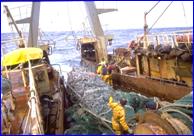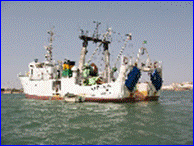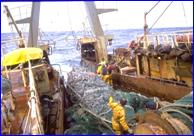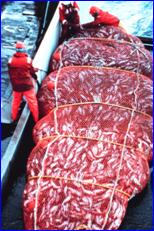Pelagic Fishing
Pelagic fishing ['Pelagos'= ocean] is done by large freezer-trawlers. The target species in pelagic fishing are small pelagic fish which swim together in shoals closer to the surface and often travel over long distances in the ocean.
The shoals of pelagic fish are tracked by marine sonar equipment. From this echo, the depth and the size of the shoal can be determined. The net is towed behind the ship just below the water surface or further down, not reaching the sea bed. The debt of the net is based on the location of the targeted shoal of pelagic fish.

Pelagic fishing equipment is constantly undergoing further improvements to ensure a more responsible and sustainable fishery.
To illustrate, large mesh sizes in the front part of the net have being designed specifically to prevent the catch of non desirable species and young fish.
The Pelagic fishing fleet is mostly made of large freezer-trawlers with a length ranging from 70 to 140 meters.
Today, most of the Pelagic fleet has freezing equipment on board. Older vessels have been upgraded over the years with on board freezing equipment and processing facilities, to get them to meet the newer standards.

To clarify the catch capacity of a freezer trawler is in fact determined by its freezing capacity; the more capacity it has the longer it can stay in the sea which means more catch thus more profits.
All fishing trawlers in West African waters have on board freezing - to maintain the freshness and quality to the EU standards.
More than 60% of a freezer-trawler on board area is used for sorting, processing, freezing and storing the catch.
Freezing the catch at sea allows the vessels to stay longer on the fishing grounds without sailing back.
From an economic point of view - as most pelagic species are of low value and transported over long distances - the efficient handling (freezing) of the product is of paramount importance.
On board freezing equipment has a great influence on the ship operational management and fishing methods.

Immediately after the catch, the whole round fish is chilled, deep-frozen (minus 23° C), packed and stored in the freezer holds of the vessel. The whole process is carried out under strict conditions of hygiene.
After 3 to 6 weeks at sea, the vessels return to the port, where the cargo is transferred to reefer vessels or to the cold storage facilities on shore,; however trans shipment can also occur at high seas (open roadstead).
Commercial pelagic fishing is possible year around in Mauritania but during the so called “biological rest period” i.e. from the 1st of September to the 30th of October (arrêté N° 1366/MPEM du 20/07/2006)
Some period of the year are more fruitful than others, depending upon the kind of fish and the movements of shoals.
The most profitable pelagic ships are those coming from Europe as they are designed according to modern standards and comprise an on board processing factory with a fish meal production line. Their usual GRT (Gross Rating Tonnage) is from 2500 up to 9000 and power ranges between 5000 and 7000 HP. They are all fitted with very powerful winches able to cope with heavy nets.

There are no limitations enforced, either regarding the ship Gross Rate Tonnage, the fish weight, the fish size or fish quantities. The sole limiting parameter is what the ship can actually catch.
In fact it’s not the available fish stock which is a concern but rather the on board processing capacity only.
Therefore an average monthly catch of 3000 tons to 5000 tons is very much achievable, depending upon ship characteristics and time at sea.


For example, the daily freezing capacity ranges between 100 and 150 tons for European built ships, i.e. 150t x 30 = 4500 tons per month.
If you want us to compute the licensing fees and expenses for your ship please Contact us and provide us with the following data:

- ♦ Name of ship
- ♦ Flag
- ♦ Radio call sign
- ♦ IMO reference
- ♦ Port of registration
- ♦ Registration number
- ♦ Year of construction
- ♦ Type of hull
- ♦ Length
- ♦ Freeboard length
- ♦ Width
- ♦ Draft
- ♦ Engine power
- ♦ Electrical generating set power
- ♦ Gross to net tonnage ratio ( London 1969)
- ♦ Number of hold
- ♦ Capacity of each hold
- ♦ Number of freezing tunnels
- ♦ Daily freezing capacity
- ♦ Number of staff members
- ♦ Type of on board processing, treatment and storing means
- ♦ Fishing gears
- ♦ Year of commissioning
- ♦ Date of latest careening


 - °
- °

